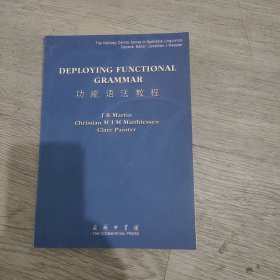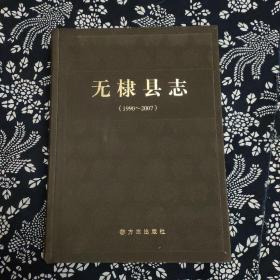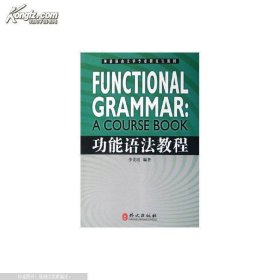
功能语法教程:Deploying Functional Grammar
¥ 69 九品
仅1件
山东济南
认证卖家担保交易快速发货售后保障
作者詹姆斯·R·马丁(J R Martin)、詹姆斯·R·马丁(J R Martin) 著
出版社商务印书馆
出版时间2010-03
版次1
装帧平装
货号G801
上书时间2024-05-25
- 在售商品 暂无
- 平均发货时间 14小时
- 好评率 暂无
- 店主推荐
- 最新上架
商品详情
- 品相描述:九品
- 书有较多曲线,字迹
图书标准信息
- 作者 詹姆斯·R·马丁(J R Martin)、詹姆斯·R·马丁(J R Martin) 著
- 出版社 商务印书馆
- 出版时间 2010-03
- 版次 1
- ISBN 9787100068512
- 定价 45.00元
- 装帧 平装
- 开本 16开
- 纸张 胶版纸
- 页数 307页
- 正文语种 英语
- 【内容简介】
-
《功能语法教程》旨在讲授及实践国际知名语言学家韩礼德所设计的多种语法分析方法,是一部适用于教学和应用方面的工具书。《功能语法教程》与韩礼德所著的《功能语法入门》(IntroductiontoFunctiona1Grammar)第二版和第三版相互参照。《功能语法教程》总结介绍了韩礼德关于小句复合体、分句、语义组和短句语法的主要观点,阐明了普遍被视为艰深的课题,并附有一系列分级练习,供学生演练学习语法分析技巧用。此外,《功能语法教程》另有一章将上述语法分析同韩礼德富有创意的话语分析、语域及文体方面的研究工作相结合。
任何对功能语言学篇章分析有兴趣的人士以及希望把韩礼德对语法的真知灼见加以实践的人士,都会发现《功能语法教程》是一本理想读物。《功能语法教程》可单独用作教科书讲授功能语法的课程,亦可配合韩礼德所著的《功能语法入门》(IntroductiontoFunctionalGrammar)或其他相关入门书籍使用。阅读《功能语法教程》无需先熟悉功能语法方面的知识,其读者对象不仅是初学者,也包括对语言学专门知识及对韩礼德的著作熟悉程度各异的其他读者。 - 【目录】
-
Prefacei
Chapter1Introduction1
1.Whatisfunctionalgrammar?1
2.Whythisfunctionalgrammar?2
3.Usingtheworkbook3
4.Gettingstartedwithtextanalysis5
5.Constituency:functionalandclassunits7
6.Reasoninginafunctionalgrammar10
7.Paradigmsassystemnetworks13
8.Choiceandconstituency16
9.LearningtouseIFG19
Chapter2Theme——clauseasmessage21
1.Orientation21
1.1ReadingguidetoIFG21
1.2CharacterisationofTheme21
1.3Thematicdevebpmentwithinatext22
2.Surveyofoptions22
2.1Ideational(topical}Theme24
2.2InterpersonalTheme25
2.3TextualTheme25
2.4SummaryoftypesofTheme26
2.5Extendingthethematicprinciplebeyondtheclause27
3.Troubleshooting28
3.1Pickingouttheunitofanalysis28
3.2IdentifyingtheTheme28
3.3Identifyingthemetafunction29
3.4SubjectitasunmarkedtopicalTheme32
3.5There'sa...:'Existential'clauses35
3.6RecognisinglongerThemeunits35
3.7'Hypotactic'clauseasTheme37
4.Analysispractice38
4.1PhaseI38
4.2PhaseII40
4.3PhaseIII47
5.Reviewandcontextualisation52
5.1DefiningTheme52
5.2ThelocationofTHEMEwithinthegrammaticalresourcesofEnglish52
5.3ThemeandMetafunction53
5.4ThemeandMood54
Furtherreading54
Chapter3Mood——clauseasexchange56
1.Orientation56
1.1ReadingguidetoIFG56
1.2CharacterisationofMood56
2.Surveyofoptions59
2.1BasicMOODtypes60
2.2Overallinterpersonalorganisationoftheclause60
2.3Interpersonalgrammaticalmetaphor67
3.Troubleshooting69
3.1Theunitofanalysis69
3.2Identifyingstructuralelements70
3.3Ambiguousmoodtype75
3.4Ambiguouspolarity76
4.Analysispractice77
4.1PhaseI77
4.2PhaseII82
4.3PhaseIII89
5.Reviewandcontextualisation93
5.1LocatingMOOD93
5.2Interpersonalstructure95
5.3Interpersonalstructureandtextualstructure95
Furtherreading96
Chapter4Transitivity——clauseasrepresentation98
1.Orientation98
1.1ReadingguidetoIFG98
1.2CharacterisationofTRANSITIVITY98
2.SurveyofoptionsI00
2.1Materialclauses102
2.2Mentalclauses103
2.3Relationalclauses104
2.4Verbalclauses106
2.5Behaviouralclauses:betweenmaterialandmental/verbal107
2.6Existentialclauses108
2.7AdditionalAgents108
2.8Ergativeinterpretation109
3.Troubleshooting112
3.1Atopologyofprocesses112
3.2GeneralprobeshelpfulinanalysingforTRANSITIVITY113
3.3Oneprocessortwo?ii4
3.4Materialclauses115
3.5Mentalclauses118
3.6Relationalclauses120
3.7Verbalclauses124
3.8BehaviouralclausesI25
3.9Discriminatingcircumstancetype126
3.10Distinguishingbetweencircumstancesandotherelements126
4.Analysispractice130
4.1PhaseI130
4.2PhaseII137
4.3PhaseIIl146
5.Reviewandcontextualisation153
5.1Theclauseasexperientialconstruct153
5.2Ergativeperspective155
5.3Relationtoothermetafunctions155
Furtherreading159
Chapter5Groupandphrase——belowtheclause161
1.Orientation161
1.1ReadingguidetoIFG161
1.2Characterisationofgroups/phrases161
2.Surveyofoptions165
2.1Nominalgroup165
2.2Verbalgroup171
2.3Othergroups182
2.4Prepositionalphrase183
3.Troubleshooting185
3.1Identifyinggroups/phrases185
3.2Assigningafunctiontoawordinagroup186
3.3Differentmeaningsforprepositions196
3.4Assigningafunctiontoaphraseoraclause:rankingorembedded?198
4.Analysispractice200
4.1Nominalgroup201
4.2Verbalgroup212
4.3Adverbialgroup&Prepositionalphrase224
5.Reviewandcontextualisation224
5.1Locatinggroups&phrases:rankandmetafunction224
5.2Nominalgroup225
5.3Verbalgroup226
5.4Prepositionalphrase226
Furtherreading227
Chapter6Theclausecomplex——abovetheclause229
1.Orientation229
1.1ReadingguidetoIFG229
1.2Characterisationofclausecomplex229
2.Surveyofoptions231
2.1TAXlS231
2.2Logico-semantictype234
2.3Summaryofclausecomplexrelations237
3.'Troubleshooting238
3.1Procedureforanalysis238
3.2Pickingouttheunitofanalysis238
3.3Complexingvs.embedding242
3.4Parataxisorhypotaxis?247
3.5Identifyingthelogico-semanticrelation248
3.6Howmany'layers'totheclausecomplex?250
3.7Implicitclausecomplexrelations251
3.8Projection251
3.9'Surfacing'fromanembedding252
4.Analysispractice253
4.1PhaseI253
4.2PhaseII259
4.3PhaselII265
5.Reviewandcontextualisation268
5.1Review268
5.2Relationsbetweenclauses270
Furtherreading271
Chapter7Textanalysis272
1.Orientation272
1.1ReadingguidetoIFG272
1.2Characterisationoftextanalysis272
2.Grammarandbeyond274
2.1Themeandinformationflow276
2.2Clausecomplexingandconjunction278
2.3Transitivityandideation283
2.4Nominalgroups,ideationandidentification284
2.5Periodicityandappraisal288
2.6Deixisandmultimodality291
3.Textanalysiscartography293
References299
Index303
点击展开
点击收起
相关推荐
— 没有更多了 —


































以下为对购买帮助不大的评价